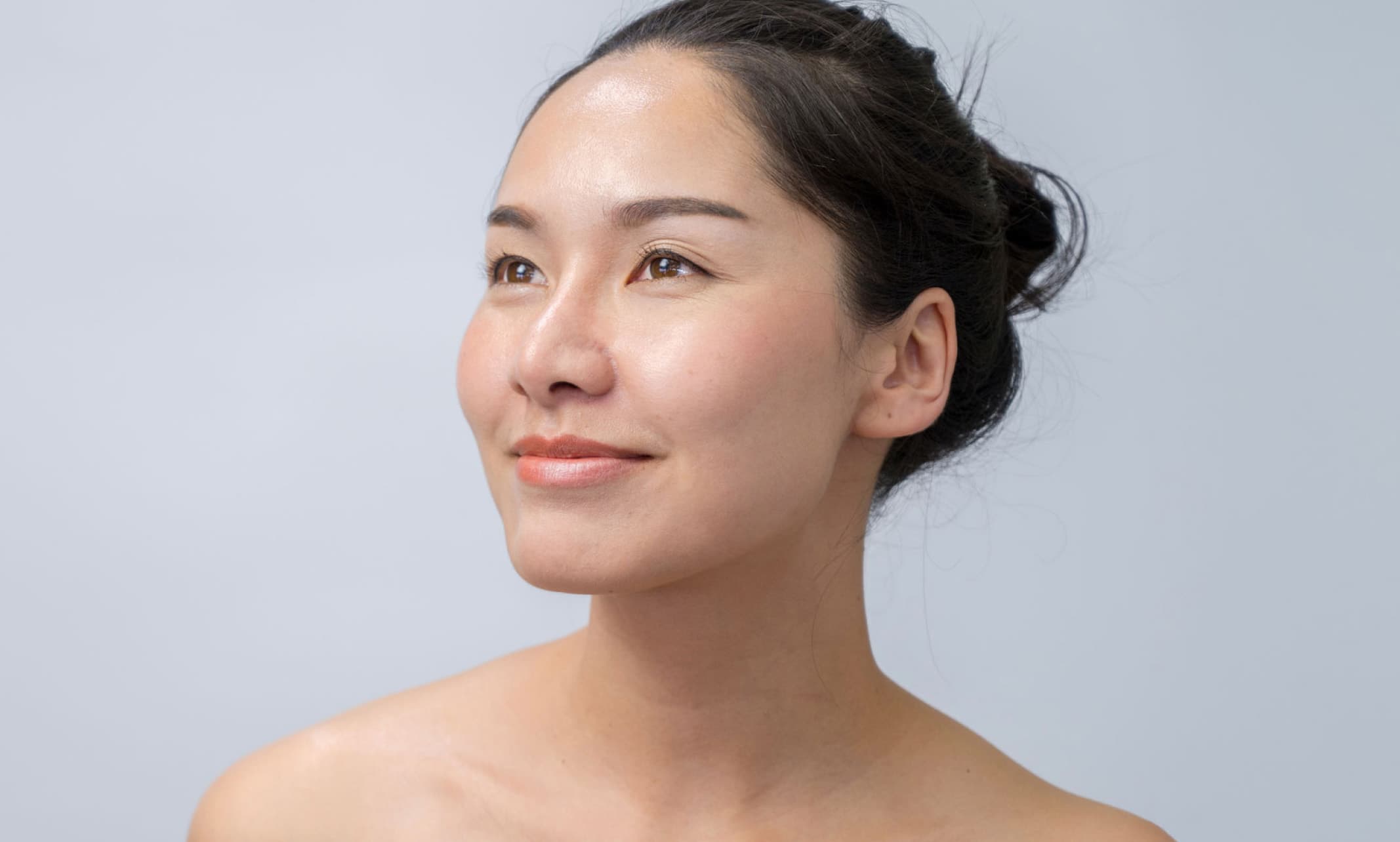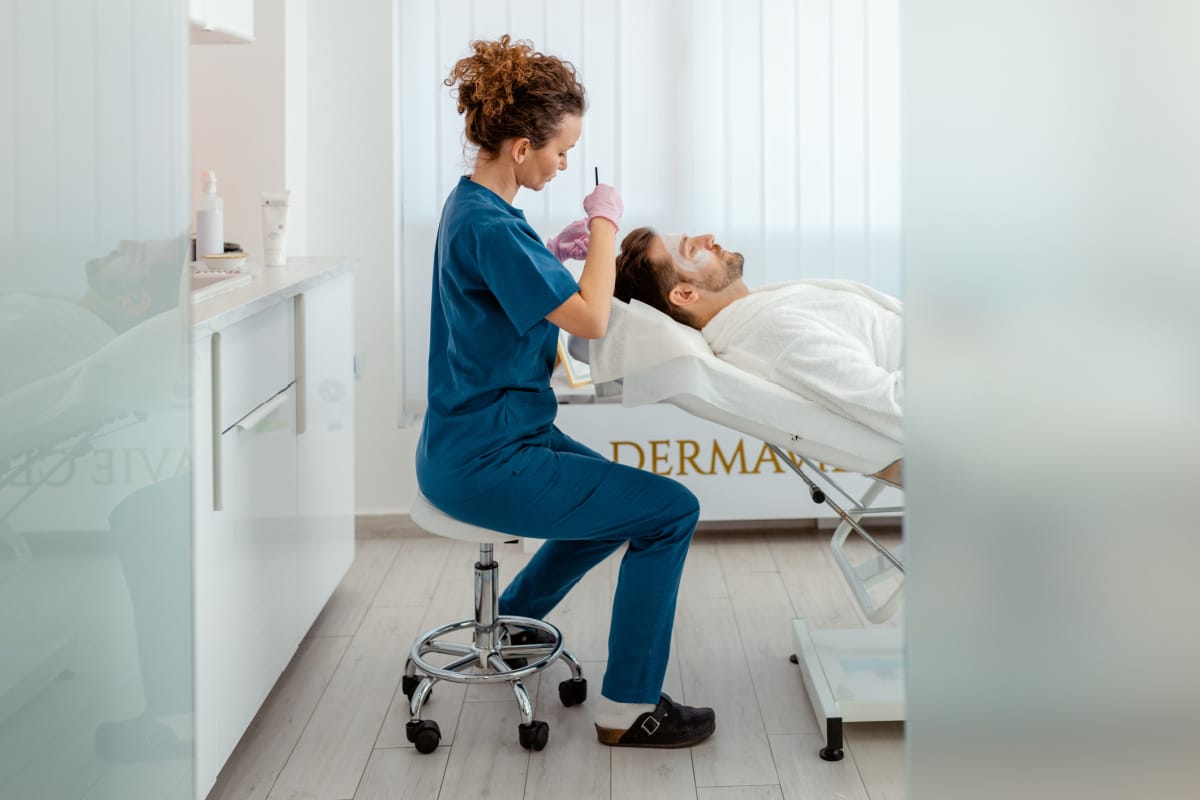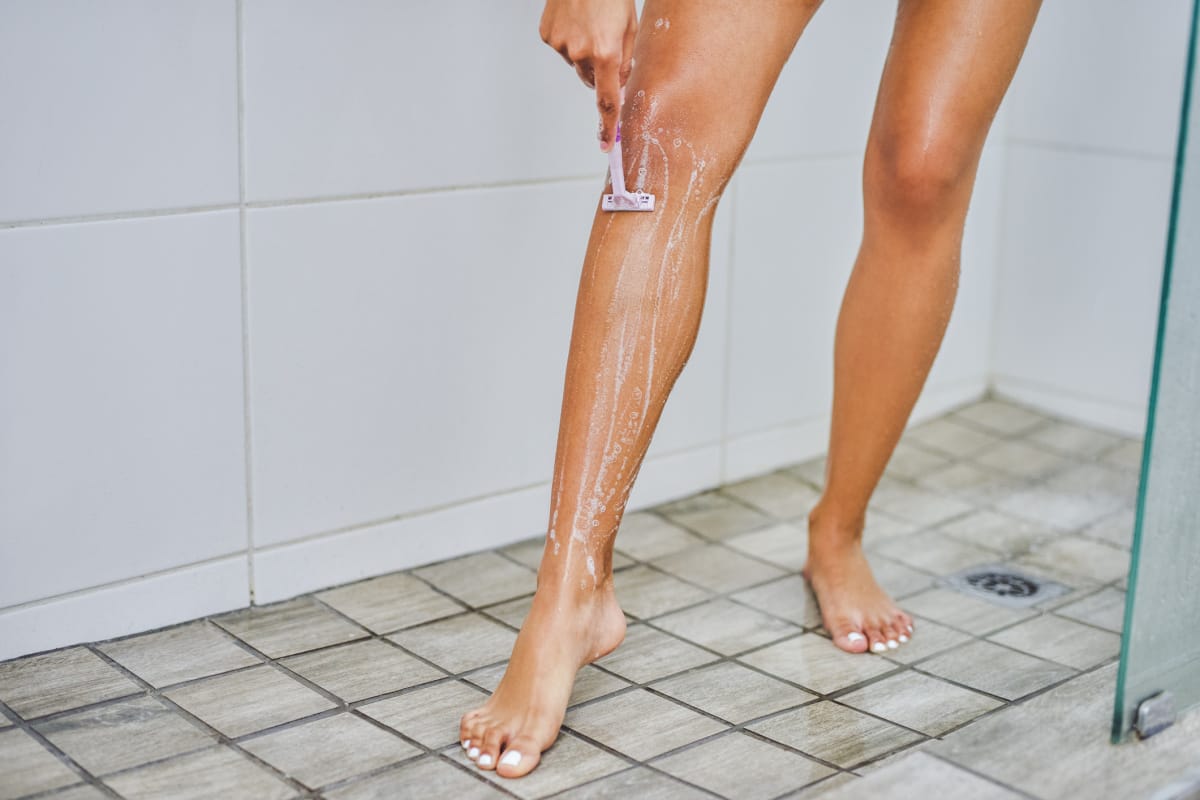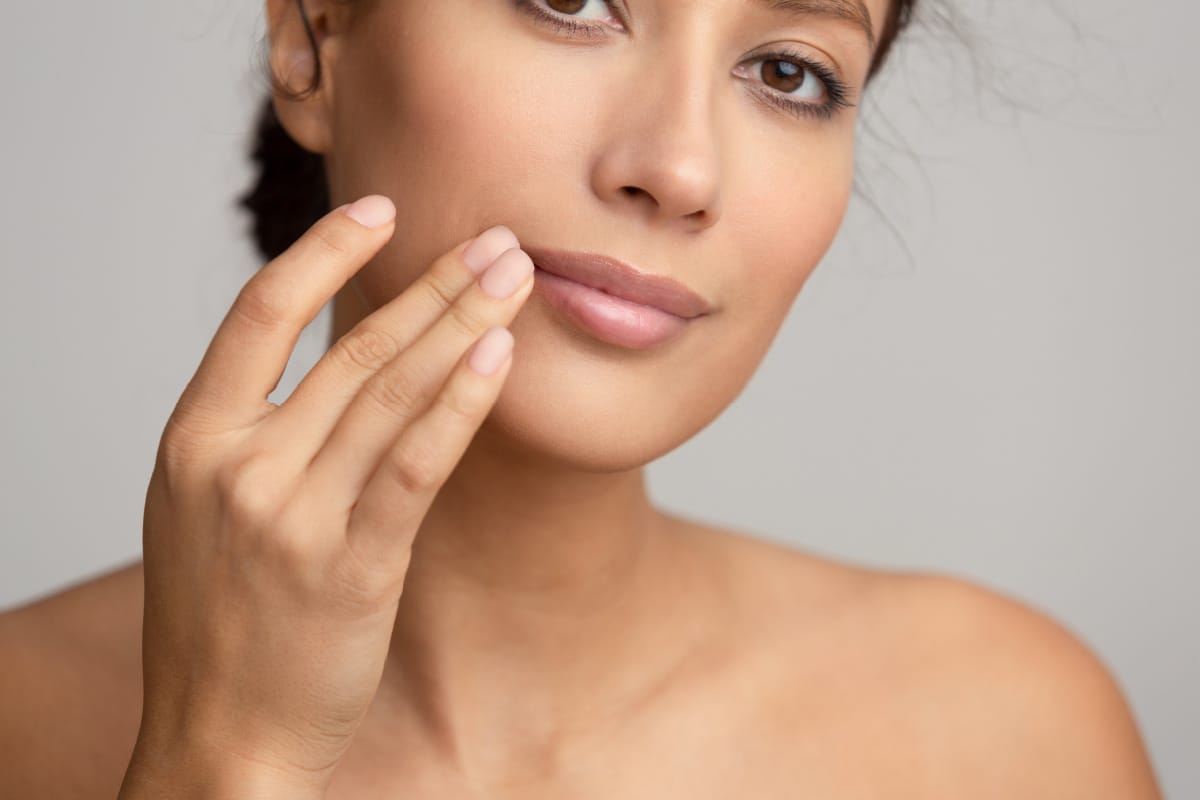CO2 laser skin resurfacing is one of the most effective, non-surgical treatments available to both transform the health and appearance of your skin and turn back the clock on aging. So if your skin is looking a little worse for wear, a customized CO2 laser skin resurfacing session at our Asheville medspa could be just the treatment you need to fall in love with your skin.
How CO2 laser skin resurfacing works and what it treats
CO2 laser skin resurfacing uses carbon dioxide (CO2) laser technology to remove layers of damaged skin tissue. The laser emits short bursts of energy that vaporize the skin’s surface and encourage the skin to heal itself by producing new collagen. The combination of removing blemished skin layers and boosting collagen growth is what makes CO2 laser skin resurfacing known for delivering more dramatic results than many other skin resurfacing methods.
Concerns we can treat with CO2 laser skin resurfacing
CO2 laser skin resurfacing is versatile and can address a wide range of skin concerns, including:
- Fine lines and wrinkles
- Sun damage and age spots
- Hyperpigmentation
- Acne
- Scarring (including acne scars and surgical scars)
- Stretch marks
- Mild skin laxity
- Crepey skin
- Rough or uneven skin texture
- Large pores
- Pigmented lesions
Your treatment is not limited to just the face, we also treat imperfections on the neck, chest, arms, and hands.
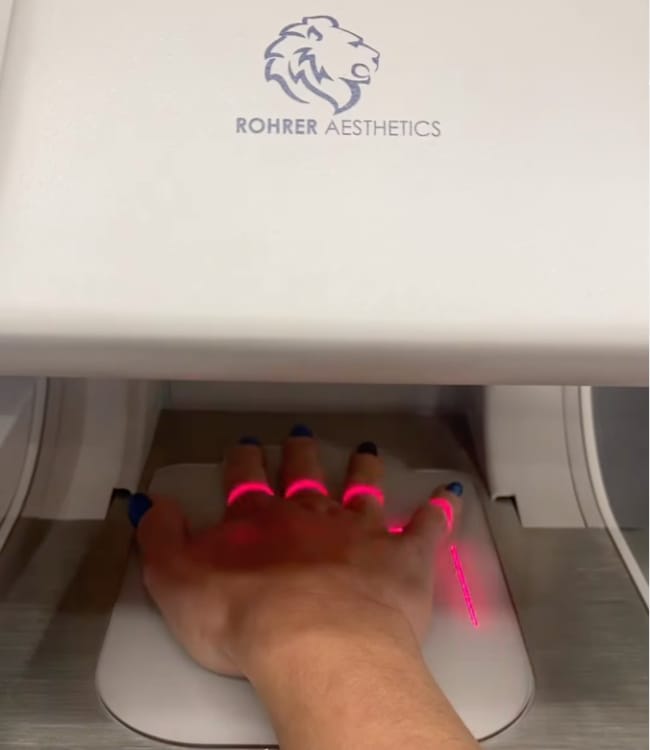
Good candidates for a CO2 laser skin resurfacing treatment
You might be a good candidate for CO2 laser skin resurfacing if you want to diminish skin imperfections and condition your skin for confident aging long term. You must also understand that there will be some downtime and some aftercare instructions to follow in order to see the best possible results. During a consultation at our Asheville medical spa, we will make sure CO2 laser resurfacing is the perfect treatment for you.
What to expect from your CO2 laser skin resurfacing consultation
Before a CO2 laser treatment, you’ll have a consultation with one of our trained laser treatment providers. During this visit, we will:
- Discuss your skin concerns and goals
- Evaluate your skin’s condition, type, and tone
- Explain the CO2 laser skin resurfacing process, expected results, and potential downtime
- Review any pre-treatment instructions, like avoiding certain skincare products or sun exposure
- Answer any questions you may have
Our team will make sure you are fully informed and help you make the best decision for your skin. If this treatment is not ideal for your needs, we may recommend one of our other laser treatments such as IPL or fractional, non-ablative laser skin resurfacing, or one of our other highly effective skin resurfacing treatments such as RF microneedling or a customized chemical peel.
CO2 treatment options & cost
CO2 Lite:
- Full face – $800 (package of 3 – $2100)
- Face and neck – $1200 (package of 3 – $3200)
- Face, neck, & decolletage – $1600 (package of 3 – $4300)
- Neck or decolletage only – $500 (package of 3 – $1300)
CO2 Complete:
- Face – $2200 (package of 3 – $5400)
- Face and neck – $3000 (package of 3 – $8100)
- Face, neck, & decolletage – $3800 (package of 3 – $10,200)
- Eyes only or around the mouth only – $1000 (package of 3 – $2700)
We will help you decide between CO2 Lite and CO2 Complete and whether multiple treatments are needed to achieve the improvement you desire.
Now offering payment plans!
Invest in your confidence today & pay for your treatment over time with Cherry or PatientFi!
Preparing for your CO2 laser skin resurfacing treatment
Because CO2 laser skin resurfacing deeply exfoliates and renews your skin, there are a few important steps we ask patients to follow for the quickest recovery and best results. Before your CO2 laser treatment, please be sure to:
- Avoid prolonged sun exposure for at least two weeks before your appointment. Treating tanned or sunburned skin may cause damage and increase the risk of potential complications.
- Pause the use of retinoids, exfoliants, or other skincare products with active ingredients about a week before your treatment to avoid over-treating your skin (our team will guide you on exactly how long you should stop certain products based on what you use at home).
- Follow any specific instructions we provide during your consultation.

The procedure
Here’s what you can expect on the day of your CO2 laser treatment:
1. Cleansing and numbing: We’ll cleanse your skin and apply a topical anesthetic to keep you comfortable during the procedure. Depending on the treatment area and your preferences, we may also use other pain relief options.
2. Laser treatment: The CO2 laser device delivers controlled fractional laser energy as we carefully pass it over your skin. You may feel a temporary warming or tingling sensation, but most clients tolerate the treatment well. We’ll check in with you throughout the short procedure to make sure you are well taken care of.
3. Immediate post-care: After your CO2 laser treatment, we’ll apply a soothing ointment to protect your skin as it heals.
Recovery & downtime
Recovery from a CO2 laser skin resurfacing treatment varies depending on the treatment depth and the area treated. We’ll explain in detail what your recovery will look like during your consultation, but in the meantime, here’s a general idea of what you can expect:
- Days 1-2: Your skin may feel warm, tight, and appear red, similar to a sunburn. Swelling and peeling are normal parts of the healing process and gradually resolve as you heal.
- Days 2-4: Some of the redness and swelling will start to go down, and you may notice your skin starting to peel. This means that your skin is producing new collagen and elastin.
- Days 4-6: Treated areas may be a little tender and itchy, which is normal, but you must avoid scratching your skin or peeling away dead skin. Let the skin slough off naturally—pulling it off may cause wounds and scarring!
- Days 6-10: Peeling continues and you will likely see patches of new skin as more of the dead skin sloughs off.
- Days 10-14: By now, peeling should be complete and most redness, swelling, and tenderness will have resolved. Your skin will continue to heal, revealing smoother, clearer, and more youthful-looking skin.
Downtime
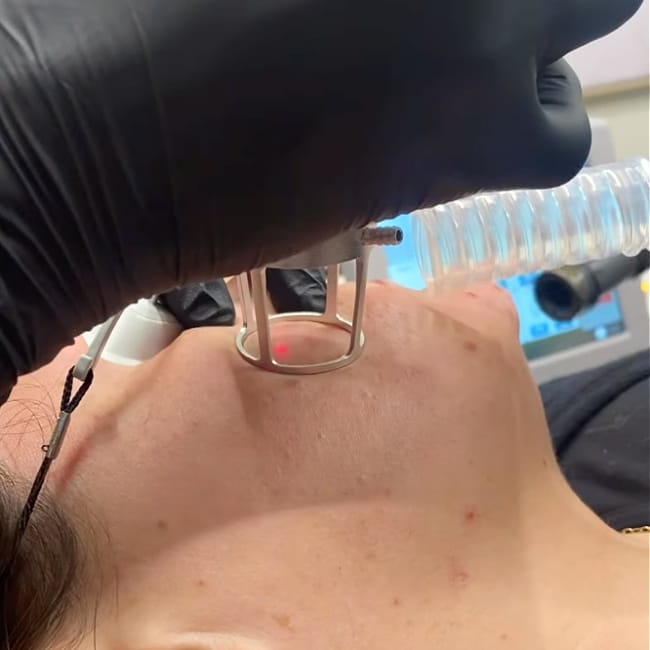
Most patients prefer about a week of social downtime, and maybe more if they are still in the shedding stages, but you should be able to resume most normal tasks after a CO2 laser skin resurfacing treatment. You must avoid sun exposure (and wear SPF if you must go outdoors) for several weeks to prevent UV rays from damaging your newly refreshed, but vulnerable skin.
There’s typically no downtime needed after treating smaller concerns such as skin tags or other lesions.
CO2 laser skin resurfacing results
CO2 laser skin resurfacing can significantly improve your skin’s appearance, but a little patience is needed to allow your skin enough time to complete the collagen regeneration process. You’ll see strong improvement in your skin concerns as your skin sheds the damaged layers, and your skin will look even better as new collagen forms in the months following treatment.
- Key Benefits
- Glossary
- Treats nearly all skin concerns in 1-2 sessions
- Less downtime than typical CO2 laser skin resurfacing treatments
- Multiple devices available to target both small and large areas quickly and comfortably
Dermatologist: A medical specialist who diagnoses and treats skin conditions, including issues that can be addressed with CO2 laser skin resurfacing.
Collagen: A protein that provides structure to the skin, which CO2 laser skin resurfacing helps regenerate for a smoother, firmer appearance.
Side effects: Potential temporary or lasting reactions to CO2 laser skin resurfacing treatments, such as redness, swelling, and sensitivity.
CO2 laser treatment: A skin resurfacing procedure that uses carbon dioxide lasers to remove damaged skin layers and stimulate new skin growth.
Sun damage: Skin changes, such as spots and wrinkles, caused by prolonged exposure to the sun’s UV rays, which can be improved with laser treatments.
Carbon dioxide: A gas used in CO2 lasers to generate precise, concentrated light energy for skin resurfacing.
Collagen production: The process of generating new collagen, which is boosted by CO2 laser skin resurfacing to enhance skin texture and elasticity.
Fractional lasers: Lasers that treat small, targeted areas of skin, leaving the surrounding tissue intact to reduce downtime and promote faster healing.
Carbon dioxide laser: A laser that uses CO2 to vaporize damaged skin cells, effectively treating wrinkles, scars, and other imperfections.
Erbium laser resurfacing: A gentler laser treatment for skin resurfacing that targets fine lines and superficial skin issues with less downtime.
Light beams: Focused streams of light energy emitted by lasers to treat specific skin concerns during CO2 laser skin resurfacing.
Acne scars: Indentations or marks left on the skin after severe acne, which can be reduced with CO2 laser skin resurfacing treatments.
Frown lines: Vertical lines that appear between the eyebrows, often treated with CO2 laser skin resurfacing for smoother skin.
Feet lines: Also known as crow’s feet, these are fine lines that form around the outer corners of the eyes, treatable with CO2 laser skin resurfacing.
Forehead lines: Horizontal lines across the forehead that can be softened with CO2 laser skin resurfacing.
Skin tones: The natural color and shade of a person’s skin is their skin tone, which can be evened out with CO2 laser skin resurfacing.
Treatment area: The specific part of the skin being treated during a CO2 laser skin resurfacing procedure, such as the face or neck.
Medication guide: Instructions provided to patients about medications.
Non-ablative lasers: Lasers that stimulate skin tightening without removing the top skin layer, leading to less downtime.
Ablative lasers: Lasers that remove the top layers of skin to reveal fresher, smoother skin underneath, often used in some CO2 laser skin resurfacing treatments.
Skin resurfacing: A procedure that removes damaged skin cells to improve texture and reduce wrinkles, scars, and other imperfections.
Potential side effects: Possible reactions to laser treatments, including redness, swelling, or mild discomfort that typically resolve within days.
Hyperpigmentation: Dark patches of skin caused by excess melanin production, which can usually be lightened with CO2 laser skin resurfacing treatments.
Infection: A rare but possible complication after CO2 laser skin resurfacing if proper care is not taken.
Scarring: Unwanted marks on the skin that may occur if the skin does not heal properly after a CO2 laser skin resurfacing procedure.
Intense pulsed light: A treatment that uses broad-spectrum light to treat skin issues like pigmentation and redness.
Fractional laser resurfacing: A technique that targets only a fraction of the skin at a time, promoting faster healing and less downtime.
Botox: An injectable treatment that relaxes muscles to smooth wrinkles.
Dermabrasion: A skin resurfacing technique that uses a rotating instrument to remove outer layers of skin.
Scar tissue: Thick, fibrous tissue that forms over healed wounds, which can be softened or minimized with CO2 laser skin resurfacing treatments.
SPF (sun protection factor): A measure of how well a sunscreen can protect skin from UV rays.
Acne: A skin condition characterized by pimples, which can lead to scars that may be improved with CO2 laser skin resurfacing.
Post-operative: Referring to the period after a procedure.
Botulinum toxin: The active ingredient in Botox.
Acne medications: Treatments used to manage acne, which may need to be adjusted before undergoing laser resurfacing.
Anesthetist: A medical professional who administers anesthesia to manage pain and comfort.
Our state-of-the-art laser technology

At Mountain Radiance, we offer fractionated CO2 laser skin resurfacing treatments using the Phoenix system by Rohrer Aesthetics. This system allows us to fully customize your treatment based on the concern(s) and the treatment area, with specialized handpieces that allow us to adjust the treatment depth (from 3mm to 30mm) to best achieve your skin rejuvenation goals without compromising your skin.
Along with multiple handpieces, the Phoenix system also has a separate hand scanner to conveniently treat the hands and arms all at once, and because we can customize the pulse duration of the laser, we can address skin concerns in multiple body areas—a significant advantage over fully ablative CO2 laser skin resurfacing treatments.
Fractional lasers achieve similar skin rejuvenation results without the recovery and downtime typically required after more aggressive, fully ablative laser treatments.
Ablative vs. non-ablative lasers
It’s helpful to understand the difference between the different types of laser treatments that are available: Ablative lasers (like most CO2 lasers) work by vaporizing the outer layer of the skin, which allows new, smoother skin to form as it heals. They’re excellent for treating deeper wrinkles, scars, and more significant textural issues, but require a longer recovery and more downtime. Non-ablative lasers use laser energy to penetrate the skin and heat deeper layers of skin to stimulate collagen growth without removing the top layer. They’re less invasive, with shorter downtime, but may require a short series of treatments to see optimal results.
Benefits of a fractional laser
A fractional laser divides the laser energy to deliver light and heat in a pixelated fashion, targeting micro-columns of skin without affecting the surrounding tissue—your skin will heal much faster than if the entire surface was treated. These micro-columns of skin are ablated (the surface is vaporized) and the deeper subdermal layers of the skin absorb the laser’s thermal energy. This controlled physical and thermal damage triggers the body’s healing response and stimulates new collagen growth. Fractional lasers can be either ablative or non-ablative.
CO2 laser skin resurfacing at Mountain Radiance uses ablative, fractional laser technology to give you the best of both worlds: excellent results with an easily manageable recovery process.
Frequently asked questions
Is CO2 laser skin resurfacing safe?
Yes, CO2 laser skin resurfacing is safe when performed by a trained and experienced provider. Like any procedure, there are some risks, but we take every precaution to ensure your safety and comfort. During your consultation, we’ll discuss your medical history and assess your skin type and condition to make sure you’re a good candidate and can safely enjoy the benefits of the treatment.
How long do the results of CO2 laser skin resurfacing last?
The results of CO2 laser skin resurfacing can last for years, especially if you take care of your skin post-treatment. Because the treatment stimulates collagen production, your skin will continue to improve in the months following the procedure. Maintaining a good skincare routine; wearing high-quality, high-SPF sunscreens; and coming in for other routine skin treatments will help prolong your results.
Does CO2 laser skin resurfacing hurt?
Comfort is a priority for us, and we make sure you’re as comfortable as possible during the treatment. Before we begin, we’ll apply a topical anesthetic to numb the skin. You might feel some warmth or tingling during the procedure, but most of our patients tolerate it well. We’ll discuss pain management options during your consultation so that your experience is as smooth as possible.
How do CO2 lasers compare to other types of lasers?
CO2 lasers are ablative, meaning they remove the outer layers of the skin, which allows for more dramatic results compared to non-ablative lasers that work beneath the surface. We use a fractional CO2 laser, which uses technology from both ablative and non-ablative lasers to give you the strong results of a fully ablative treatment with downtime that’s similar to a non-ablative treatment.
Our trained CO2 laser providers have the knowledge and experience to achieve a stunning skin transformation and minimize your downtime. Ready to learn more or book your consultation? Call us at (828) 627-2711 or fill out the contact form below.
